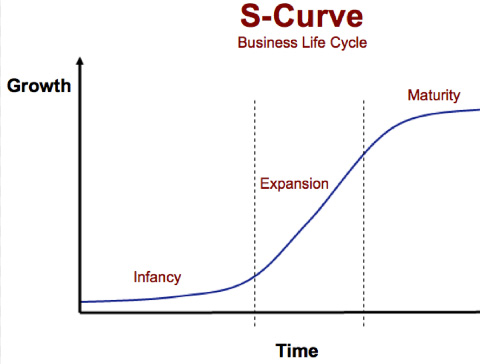Running a small business can be more demanding than expected, often leaving entrepreneurs feeling stressed and unsure about their growth strategies. Donald Miller’s “How to Grow Your Small Business” presents a 6-step plan for achieving reliable and consistent growth. This guide helps you create a plan for your business, enabling you to prioritize both your business and personal passions.
Key Idea No. 1: Why Grow Your Small Business
Running a business is filled with challenges, especially when navigating the tricky “s-curve” of growth and decline. This pattern starts with exciting growth due to high demand, but soon businesses often struggle as owners find themselves bogged down in solving daily problems rather than focusing on innovation and expansion.

If you feel your business is too dependent on you or if you spend more time putting out fires than selling products, you might need to professionalize your operation too. Developing systems and processes to run your business like a machine might be the step you need to take. Businesses usually fail for one of six reasons:
- Failure to identify and prioritize economic objectives
- Failure to market products with a clear message
- Failure to sell in a way that makes the customer the hero
- Producing products that aren’t in demand or profitable
- Bloated overhead due to inefficient management and productivity
- Mismanagement of cash and cash flow
Think of your business like an airplane: for it to fly smoothly, all parts need to function seamlessly. Professionalizing your business ensures that all components – from economic objectives and marketing strategies to management practices and cash flow – are operating efficiently and harmoniously. This systematic approach not only helps you navigate the s-curve of growth and decline but also positions your business for long-term success.
By taking the time to professionalize your business, you move from a reactive state to a proactive one. You gain the ability to focus on innovation and expansion rather than constantly putting out fires. In turn, this enables you to build a resilient, scalable, and profitable business that can weather challenges and capitalize on opportunities.
Key Idea No. 2: Become a Business on a Mission

Running a successful business requires more than just hard work – it requires a clear mission. A mission provides direction, purpose, and a framework for growth, much like a flight plan for a pilot.
As a leader, it is your primary job is to define a clear destination and create a plan to get there. This involves crafting a mission statement with specific, measurable goals and deadlines. Instead of vague aims like “satisfying customers,” set clear targets such as “triple the number of coaching clients in the next twenty-four months.”
A robust mission statement does three things: it sets clear economic priorities, includes a deadline, and explains why the mission matters.
- Clear Economic Priorities: Your mission should include measurable objectives, such as “increase revenue by 35% and profit margin by 12%.” This clarity helps your team understand what success looks like and how to achieve it.
- Deadline: Setting a timeline creates urgency and focus. A mission without a deadline lacks the pressure needed to drive consistent effort and progress.
- Purpose: Explaining why the mission matters connects the team’s work to a larger purpose. For instance, a real estate office might aim to sell one hundred homes “because everyone deserves to walk into a home they love.” This connection to a higher purpose can significantly boost morale and dedication.
An inspiring mission statement doesn’t just guide your business; it attracts top talent. Talented individuals seek workplaces that offer growth opportunities and a clear sense of direction. To achieve your mission, you need to identify and develop specific key characteristics in your team.

Key Characteristics are like core values but more specific. They highlight the skills and traits necessary for your business’s success. For example, a software company might prioritize a team obsessed with simplifying interfaces, while a pet store seeks animal lovers.
When defining your Key Characteristics, consider:
- What traits are needed to create or sell products that solve customer problems?
- What characteristics will help us persevere during challenging times?
- What qualities will foster a safe, encouraging culture?
Keep this list short, around three traits, to ensure they are memorable and actionable. For instance, a local restaurant might have the following Key Characteristics:
- We love people and enjoy serving them.
- We are obsessed with great-tasting food.
- We are calm under pressure.
These characteristics guide behavior and help the team know how to act, leading to positive customer experiences and a better working environment.
Key Idea No. 3: Use a Clear Marketing Message

In the competitive landscape of modern business, selling a product is often a daunting challenge. Many businesses struggle with communicating their value propositions effectively. You may find that despite your efforts, people aren’t engaging with your products, your website and ads are not persuasive, or your social media presence lacks coherence. If this sounds familiar, rest assured that you’re not alone.
The root of these problems often lies in the clarity of your marketing message. The solution is to articulate your offerings in simple, clear language that resonates with your audience and motivates them to buy. This approach isn’t about deceiving customers; it’s about transparency and trust-building.
While many businesses emphasize the visual appeal of their marketing materials, the significance of the words used cannot be overstated. Aesthetics are important, but if your message doesn’t capture attention and convey value, potential customers will move on. The right words can either attract or repel customers. When visitors land on your site or open your emails, they’re seeking information that can improve their lives. If your message fails to communicate this effectively, they’ll simply ignore it.
To use words effectively in attracting customers to your products, consider these key strategies.
Focus on Customer Needs: Highlight how your products help people survive and thrive. Instead of boasting about your company’s history or achievements, concentrate on the problems your products solve.
Use Clear, Simple Language: In a world saturated with information, clarity is paramount. If your message is not easy to understand, it will be overlooked. Aim for brevity and simplicity.

Leverage Storytelling: Storytelling has an innate power to captivate audiences. Here is a breakdown of seven-part framework, which provides a structured approach to crafting a compelling narrative that places your customers at the center:
- Character Who Wants Something: Start by identifying something specific your customers want. The more specific you are, the more compelling your story becomes.
- Must Overcome a Conflict: Heroes in stories face challenges. Similarly, in your marketing, talk about the problems your customers face and how your product can solve them. This opens a story loop that they must buy your product to close.
- Meets a Guide: Position yourself as the guide, not the hero, in your customer’s story. Express empathy with their problems and demonstrate authority in solving them.
- Give Them a Plan: Provide a clear, simple plan for customers to follow. This helps them see the journey from their problem to your solution as easy and safe.
- Call Them to Action: Clearly ask your customers to take action, such as placing an order. Use direct language like “buy now” or “schedule an appointment.”
- So the Hero Can Avoid Failure: Highlight the negative consequences customers will avoid by buying your product. People are motivated to avoid discomfort, so reminding them of what they’ll miss out on without your product can be a powerful motivator.
- Experience Success: Paint a picture of the positive, amazing things customers will experience if they buy your product. This adds perceived value to your product and makes it more appealing.
In summary, the clarity of your marketing message is integral to your business’s success. By focusing on how your products enhance your customers’ lives and communicating this in a clear, engaging manner, you can craft a message that resonates deeply with your audience. This approach not only attracts attention but also drives action, fostering growth and success for your business.
Remember, words are powerful. Use them wisely to build connections, trust, and loyalty with your customers.
Key Idea No. 4: Craft a Million-Dollar Sales Pitch
In business, sales can often feel like an uphill battle, with challenges ranging from discomfort with selling to closing deals and gaining customer trust. However, a transformative approach exists that can alleviate these pain points and drive success: the integration of storytelling into sales strategies.

Recognize that every customer is the hero of their own story, seeking solutions to their problems. Traditional sales tactics often feel manipulative and off-putting. Instead, crafting a narrative that invites customers into a journey where their needs are paramount shifts the focus from selling to helping. This paradigm shift not only aligns marketing and sales efforts but also cultivates trust and authenticity in customer interactions.
At the core of this methodology is the concept of the million-dollar sales pitch – a pitch that transcends the size of your business and consistently drives revenue. By understanding the customer’s journey and framing products or services as tools to overcome challenges and achieve desired outcomes, businesses can create compelling narratives that resonate with their audience.
One key aspect of this approach is the use of color-coded storytelling. By highlighting elements such as the customer’s problem (red), the proposed solution (purple), and the envisioned outcome (blue), sales pitches transform into captivating stories that captivate and compel action. This visual representation not only simplifies the sales process but also ensures that every interaction with a potential customer is rooted in storytelling principles.

Moreover, adopting this approach empowers sales teams to navigate conversations with confidence and clarity. Instead of focusing on selling, the emphasis shifts to understanding and addressing the customer’s needs, fostering genuine connections and driving long-term success.
The impact of this approach extends beyond individual sales conversations to shape the overall culture of a business. By embracing storytelling as a fundamental aspect of sales, organizations can cultivate a customer-centric mindset and foster a reputation built on trust and authenticity.
Key Idea No. 5: Optimize Your Product Offering
Running a small business is no easy feat, but optimizing your product offerings can make a world of difference in your profitability and overall success. It’s all about smart evaluation and strategic action. Here’s a simple guide on how to fine-tune your products to boost your financial outcomes.
- Evaluate Your Current Product Lineup: First, take a good look at what you’re currently offering. It’s essential to rate your products based on profitability. List all your products and rank them. This isn’t just about seeing which ones bring in the most revenue but understanding which ones are the most profitable. This exercise will help you identify which products deserve more marketing and sales effort. Focus your resources on the high-performers and consider letting go of those that aren’t pulling their weight. It’s all about making your business leaner and more efficient.
- Innovate with New Offerings: Next, it’s time to get creative and think about adding new, profitable products to your lineup. Brainstorming new product ideas can open up new revenue streams. Consider a variety of products, like coaching sessions, workshops, digital products, bundles, or even free trials that could convert into paid services. The key here is to think about what will provide the most value to your customers and how you can meet their needs in new and innovative ways.
- Plan Your Launch Strategically: Once you have your ideas, don’t rush into launching them. Create a product brief for each new idea. This is a detailed plan that evaluates the potential profitability, demand, and feasibility of the product. By doing this, you ensure that you’re not wasting time and resources on products that won’t succeed. A well-thought-out product brief helps you mitigate risks and plan for a successful launch.
Optimizing your products isn’t just about cutting the fat; it’s about building a stronger, more resilient business that can thrive in any market. By following these three steps, you can streamline your product offerings, make the most of your resources, and drive business growth.
Key Idea No. 6: Streamline Your Overhead & Operations
Managing overhead costs is a crucial aspect of running a successful small business. Every dollar saved on expenses contributes directly to the overall financial health of your business and can make a significant difference in profitability. One effective strategy for managing overhead costs is to focus on labor efficiency.

Labor costs are often one of the largest expenses for small businesses. This includes salaries, wages, benefits, and other expenses associated with employees. Therefore, finding ways to optimize labor efficiency can have a substantial impact on overall expenses. Here’s why labor costs can be the prime factor for business failure:
- High Fixed Costs: Salaries and wages represent fixed costs that a business must pay regardless of its revenue. When sales decline, these fixed costs can quickly become unsustainable, leading to cash flow problems. Unlike variable costs that fluctuate with production levels, labor costs remain constant, creating financial strain during lean periods.
- Operational Inefficiencies: Poorly managed labor can result in operational inefficiencies, such as overstaffing or underutilization of employee skills. This not only wastes resources but also reduces productivity. For example, if employees are not efficiently allocated or if their roles are not clearly defined, the business may end up paying more for less output.
- Employee Turnover: High labor costs can also be a symptom of high employee turnover. Recruiting and training new employees is expensive, and constant turnover disrupts business operations. The time and resources spent on hiring and training new staff can divert attention from core business activities, further worsening the financial situation.
Therefore, focusing on labor efficiency is key to managing labor costs. Structured meetings play a crucial role in achieving this efficiency by ensuring clear communication, alignment of goals, and continuous improvement. Here are some strategies to manage labor costs effectively through structured meetings:
- Leadership-Level Communication: At the leadership level, clear communication fosters a cohesive team that can steer the organization effectively. Regular discussions about initiatives and roadblocks ensure everyone is working towards common objectives. By aligning leadership on strategic priorities, businesses can make informed decisions that optimize labor use.
- Departmental Meetings: Within departments, short daily meetings help set objectives and quickly address issues, maintaining a steady workflow and boosting team morale. These meetings ensure that teams are aligned on daily goals and can promptly address any operational hiccups that may arise, thereby enhancing productivity.
- One-on-One Meetings: One-on-one meetings between managers and team members ensure individual accountability and focus on high-priority tasks, reducing wasted effort and improving productivity. These personalized interactions allow managers to provide targeted feedback and support, helping employees stay on track and perform efficiently.
- Regular Performance Reviews: Regular performance reviews assess individual performance and discuss improvements. By evaluating employee contributions systematically, businesses can identify areas for development and recognize high performers, which can enhance overall productivity and reduce turnover.
Labor costs are a significant factor in the financial health of a small business. However, by focusing on labor efficiency and implementing structured meetings, businesses can improve their profitability and sustainability in the long run.
Key idea No. 7: Get Control of Your Finances

Managing finances is often one of the most daunting tasks for business owners. Even with a solid business model and exceptional products or services, poor financial management can lead to significant challenges, including running out of money.
To streamline financial management, ensure steady growth, and help businesses avoid the dreaded cash crunch, small businesses should divide finances into five distinct checking accounts: Operating, Personal, Business Profit, Tax, and Investment Holding. Each account serves a specific purpose, contributing to a transparent and efficient financial management process.
- Operating Account: The Operating Account is the heart of the system. All business revenue flows into this account, and all expenses are paid from it. By maintaining this account separately, business owners can easily track the financial health of their operations without confusing business expenses with personal ones. This clear demarcation is essential for accurate financial tracking and decision-making.
- Personal Account: A fixed salary is transferred from the Operating Account to the Personal Account. This separation is crucial for maintaining a clear boundary between personal and business finances. It ensures that business owners live off a consistent income, which helps establish a predictable financial rhythm for the business.
- Business Profit Account: Excess funds not immediately needed for business operations are stored in the Business Profit Account. This account acts as a rainy-day fund, providing a financial cushion during tough times. By transferring surplus money to this account, businesses can ensure they remain financially secure even in adverse conditions. It helps in building a reserve that can be crucial for navigating unexpected challenges.
- Tax Account: Regularly transferring money into the Tax Account ensures that funds are available to cover tax obligations when they arise. This practice prevents the common pitfall of using tax money for other expenses, which can lead to cash shortfalls during tax season. Proper tax management is essential for maintaining the business’s financial health and avoiding penalties.
- Investment Holding Account: Funds exceeding the needs of the Business Profit Account are placed in the Investment Holding Account. This money can be used for investments such as real estate, stocks, or other ventures that generate additional income. This account helps in growing personal wealth without constant oversight, allowing the money to work for the business owner.

This five-account system for business finances offers clarity and stability by segregating funds, ensuring preparedness for emergencies and taxes, promoting sustainable growth and wealth accumulation, and enabling focus on business growth through streamlined financial management.
In conclusion, Donald Miller’s “How to Grow a Small Business” is an invaluable resource for entrepreneurs seeking practical and actionable advice to grow their businesses. The book’s organization, using the metaphor of an airplane to represent different business components, makes complex concepts easy to understand and implement. Each section, from leadership to finance, offers crucial insights that can immediately impact your business growth. For any entrepreneur looking to elevate their business, this book is a must-read.

Leave a Reply